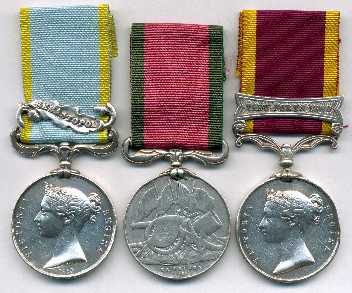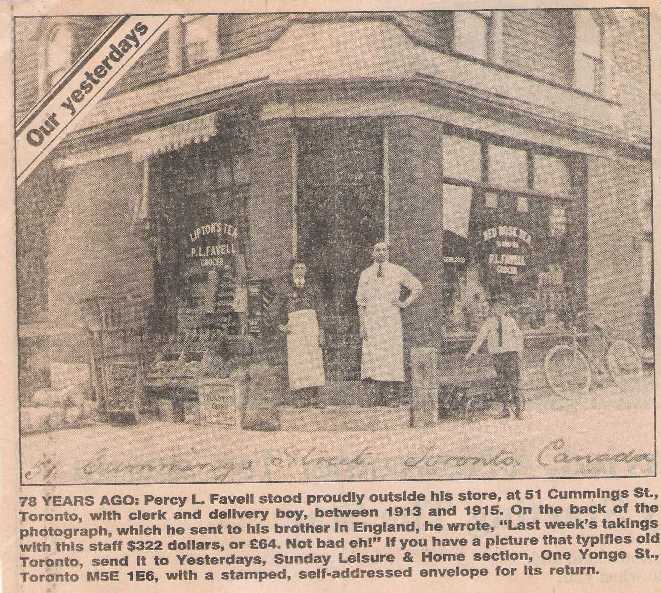
3343 Private George Favell 31st Regiment of Foot

George was employed as an
agricultural labourer, as were several of his brothers.
A younger sister Sarah (age 15) was working as a Servant, while the remaining five
children were all of school age or younger. George
and the other children that were working probably all had to contribute to help feed and
clothe the younger members of the family, and the elder children moving out into lodgings
was probably a practical arrangement simply for reasons of space.
Little wonder then that the
smartly dressed recruiting Sergeant and his
party were able to entice the young George to accept the Kings Shilling with the promise
of a smart uniform, food, clothing, travel and an opportunity to escape from the hardships
of life in a small farming village. He
enlisted in the 31st Foot at Hemingford Abbots on the 13th February
1852 at the age of 17 years and 10 months.
By 1854 the 31st were stationed at Corfu,
shortly before the outbreak of the Crimean War and were reinforced before embarking for
Balaclava. George may have been embarked to
Corfu shortly after enlisting, or may have been part of these reinforcements.
Lessons learned by Wellington's army during the Penninsular war nearly forty years earlier had all but been forgotten. The army had been neglected by the politicians for years and starved of funds. The army that landed in the Crimea was wearing the same uniforms that it wore on the parade ground and was not equipped with the clothing, tents or supplies needed to cope with the severe winter they were facing. Thousands of troops died from the cold and from disease and it was at this time that Florence Nightingales work came to the fore and resulted in the establishment of army hospitals. It is a sobering thought that 27,000 Officers and men were invalided or died of disease during the winter of 1854-1855 compared to only 2,769 killed and wounded by enemy action during the whole campaign. Many of the service corps supporting the armies logistics and supplies were also introduced as a result of this period. The 31st took part in the assault on Sebastopol where the British army made two unsuccessful attempts to overcome the Russian defenders before the French army finally forced the Russians to flee.
After the Crimean War the 31st
were assigned to the Maltese island of Gozo before moving on to King Williams Town on the
Cape of Good Hope where George's service record shows he stayed for 4 months. It was in April 1857 that George was awarded
his first good conduct pay of 1 1/2d a day.
In 1859 the regiment was
moved to Poona in India and readied for active service in China and again reference to
George's service record shows that he was stationed in the East Indies for 1 year and 4
months. It was on the 25th
December 1859 that he was promoted to the rank of Corporal and by April 1860 his good
conduct pay was increased to 2 1/2d a day.
When the Mandarins broke the
Treaty of Tienstin in 1860 the British armies moved into China and arrived at the Peiho
river near the town of Pehtang on the 12th August 1860. The Taku forts were the main objective and were
taken on the 21st August and a truce was called on the 24th October. The 31st became part of the new
garrison at Tienstin. While in China, George
was promoted to the rank of Sergeant in February 1861.
The 31st remained in China until 1863, after which it returned to
England. George served in China for a total
of 3 years and 9 months.
By this time George had
completed his ten years service, but rather then claim his discharge he promptly signed on
for another 11 years.
When George returned to England
he returned with his medals awarded for his part in the Crimean war and China campaign. He was awarded the Crimean Medal with bar for
'Sebastopol', the Turkish Crimean Medal, awarded by the Turkish Emperor to the allied
armies and the second China War Medal with bar for 'Taku Forts 1860'.
Shortly after his
re-engagement things took a turn for the worse for George.
Maybe he had second thoughts about re-enlisting or maybe he over celebrated in some
way, but on 1st December 1863 he was tried and impeached by Court Marshal for
absence. Two days were discounted from his
service for 1st and 2nd of December and are excluded from counting
towards his service or his pension. Possibly
he was sentenced to 2 days in the guard house or some other form of punishment. He was stripped of his Sergeant's rank and
returned to the rank of Private, loosing his good conduct pay into the bargain. By the 3rd December of the following
year George had re-earned the first of his good conduct pay.
George returned to his old home
while on leave in England and was married to 21 year old Sarah Lavender at Hemingford
Abbots on the 28th September 1865. In
the register entry his profession is given as soldier and place of residence as Aldershot. George's wife may have been allowed onto the
strength of the regiment as she appears to have travelled with him to overseas postings,
judging by the births of their children.
In December 1866 George's good conduct pay was increased
to the level of 3 1/2d per day and in the following year, George and Sarah's first
daughter was born in Malta. In October of the
same year George was promoted to Corporal, for the second time in his career. A son was born in 1870, again in Malta and the
same year his good conduct pay reached the level of 4d a day.
In 1872, on the 30th March, George returned to
the rank of Sergeant. A further son was born
to George and Sarah in 1873, but this time the place of birth was Gibraltar where George
second term of service came to an end after a total of 21 years service. The family returned to England where George was
finally discharged at Netley, the newly built army hospital overlooking Southampton
Water. George left the 31st at the
age of 39 years and 1 month. His description
at the time shows him to be 5 feet 6 inches tall with a fresh complexion, blue eyes and
dark brown hair. The notes show he had
several decayed teeth, the veins of his left leg were enlarged and he had "VS"
tattooed on his right arm. His trade was
still regarded as 'Labourer' and his intended place of residence was Huntingdon.
Another four children were born in Hemingford Abbots and St Ives in Huntingdonshire between the years of 1876 and 1884. In the 1881 census George is listed as living in St Ives and his occupation is given as Pensioner Servant. At the 1901 census he was still living in St Ives and listed as an Army Pensioner.
Information received from Georges descendants is that one of his sons, Percy, emigrated to Canada and the Percy L Favell referred to in the press cutting below is likely to be the same man.
